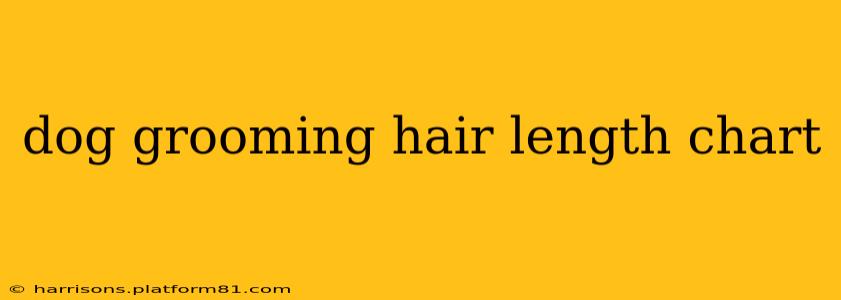Choosing the right haircut for your furry friend can be a daunting task. With so many breeds and styles, knowing where to start can be overwhelming. This comprehensive guide provides a helpful dog grooming hair length chart and explains the different lengths and their associated grooming needs. Understanding these factors will help you and your groomer achieve the perfect look for your dog.
What is a Dog Grooming Hair Length Chart?
A dog grooming hair length chart isn't a single, universally accepted chart, but rather a conceptual framework. It helps visualize the different hair lengths commonly used in dog grooming. These lengths are usually described using terms like "short," "medium," and "long," but these are relative and can vary greatly depending on the breed and the groomer's interpretation. Therefore, it’s always best to discuss your desired length with your groomer using visual aids like pictures or descriptions, rather than relying solely on a numerical measurement.
Common Dog Grooming Hair Lengths and Descriptions
While there isn't a standardized chart with exact measurements in inches or centimeters, we can define common hair length descriptions used in dog grooming:
-
Short: This typically refers to a very close clip, often down to the skin. It's common for breeds prone to matting or for dogs who need a low-maintenance style. Think of a "puppy clip" or a very short buzz cut.
-
Medium: A medium length allows for some texture and styling options. It's generally longer than a short clip but still relatively easy to maintain. This length is ideal for many breeds and allows for a blend of practicality and style.
-
Long: This refers to the dog's natural coat length, or a style that retains a significant portion of it. Long coats require more frequent grooming to prevent matting and tangles. Regular brushing is a must.
How to Determine the Right Hair Length for Your Dog
Choosing the right hair length depends on several factors:
-
Breed: Different breeds have different coat types and textures. Some breeds naturally have short hair, while others have long, thick coats. Certain breeds are also more prone to matting than others.
-
Coat Type: Is your dog's coat straight, wavy, curly, or wiry? This greatly impacts the ease of grooming and the maintenance required for different lengths.
-
Lifestyle: An active dog might benefit from a shorter, easier-to-maintain cut, while a more sedentary dog could handle a longer style.
-
Grooming Habits: Are you prepared to brush your dog frequently? Longer coats require far more regular brushing.
-
Personal Preference: Ultimately, the best hair length is the one that you and your dog find most appealing and manageable.
H2: What are the different types of dog haircuts?
There are numerous dog haircuts, each with its own style and level of maintenance. Some popular examples include the:
- Puppy cut: A short, all-over clip.
- Lion cut: Commonly seen on breeds like Shih Tzus and Poodles, leaving longer hair on the head, legs, and tail.
- Schnauzer trim: A stylized cut emphasizing the breed's natural features.
- Teddy bear cut: A very popular cut that leaves the dog with a soft, cuddly appearance.
These are just a few examples, and many variations exist depending on breed and personal preferences.
H2: How often should I groom my dog?
Grooming frequency depends on the dog's coat length and type. Dogs with short, smooth coats may only need occasional baths and brushings, while long-haired dogs may require weekly or even daily brushing to prevent matting. Regular professional grooming is also recommended to maintain a healthy coat and skin.
H2: How much does dog grooming cost?
The cost of dog grooming varies widely depending on the location, the groomer, and the type of services required. It’s best to contact local groomers for price quotes.
H2: What tools do I need for dog grooming at home?
For basic at-home grooming, you'll need a good quality brush (appropriate for your dog's coat type), nail clippers, and dog shampoo. More specialized tools may be needed for longer or more complex coat types.
Remember, this information serves as a general guide. Always consult with a professional dog groomer to discuss your dog's specific needs and to achieve the best and safest grooming outcome. They can advise on the most suitable haircut, grooming schedule, and products for your furry friend.
